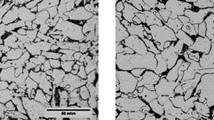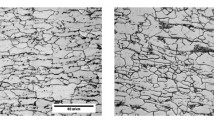Using contemporary physicochemical approaches for predicting phase precipitate stability conditions for laboratory melted metal by optical, scanning, and transmission electron microscopy, local X-ray spectral analysis, testing mechanical characteristics, and determining the content of interstitial elements in solid metal a detailed study is made of the structural state and properties of titanium stabilized IF steels of three compositions. Based on the results obtained, the main requirements for hot-rolled steels are formulated, and the principles and conditions for obtaining good ductility and formability indices are determined for cold-rolled product subjected to recrystallization annealing by a continuous hot-dip galvanizing unit (HDGU) regime.





Similar content being viewed by others
References
A. I. Zaitsev, I. G. Rodionova, E. S. Klyueva, et al., “Study of the content of interstitial impurities in IF-steels by internal; friction,” Probl. Chern. Met. Materialoved., No. 3, 78–85 (2019).
V. M. Prikhod’ko, Metal Physics Bases of Developing Strengthening Technology [in Russian], Mashinostroenie, Moscow (2003).
N. G. Shaposhnikov, B. M. Mogutnov, S. M. Polonskaya, A. P. Kolesnichenko, and P. B. Belyavskii, “Thermodynamic modeling as a tool for improving heating technology for ingots of steel 12Kh18N10T for rolling,” Materialovedenie, No. 11, 2–9 (2004).
A. I. Zaitsev, I. G. Rodionova, A. A. Pavlov, N. G. Shaposhnikov, and A. V. Grishin, “Effect of composition, structural state, and manufacturing technology on service properties of high-strength low-carbon steel main bimetal layer,” Metallurgist, 59, No. 7, 684–692 (2015).
F. Dong, F. Xue, L. Du, and X. Liu, “Promoting Ti4C2S2 strain induced precipitation during asymmetrical hot rolling to improve the value and advantaged texture in Ti stabilized IF steel,” J. Alloys Comp., 620, 240–248 (2015).
Author information
Authors and Affiliations
Corresponding author
Additional information
Translated from Metallurg, Vol. 64, No. 2, pp. 49–55, February, 2020.
Rights and permissions
About this article
Cite this article
Zaitsev, A.I., Rodionova, I.G., Koldaev, A.V. et al. Effect of Hot Rolling Regimes on Solid Solution Structure, State and Properties of Titanium-Stabilized if-Steel Hot-Rolled and Cold-Rolled Product. Metallurgist 64, 136–144 (2020). https://doi.org/10.1007/s11015-020-00975-0
Received:
Published:
Issue Date:
DOI: https://doi.org/10.1007/s11015-020-00975-0




